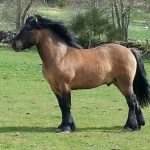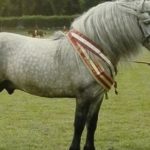Highland Pony
The Highland Pony is a breed of domestic ponies that developed in Scotland. This is an extremely old breed, and is known for its commendable hardiness and endurance. Initially used as a workhorse, they are now used mainly for riding purposes. Despite its increasing popularity, there is a gradual decline in its population. The breed has been categorized under ‘Category 4’ (“At Risk”) by the Rare Breeds Survival Trust.
Highland Pony Pictures
- Black Highland Pony
- Dun Highland Pony
- Highland Ponies
- Highland Pony Foal
- Highland Pony Head
- Highland Pony Images
- Highland Pony Jumping
- Highland Pony Mare
- Highland Pony Pictures
- Highland Pony Stallion
- Highland Pony Studs
- Highland Pony
Quick Information
| Physical Characteristics | The body is not too short, but defined, with an attractive, well carried head atop a medium neck and a deep chest; the eyes look bright and kind; the hindquarters are well-developed and strong with the legs having broad knees and a silky feathering; the feet are broad and are in good shape; the tail and mane are very dense and long; the stallion/stud is a little larger than the mare |
| Temperament | Even-tempered, obedient, willing, docile |
| Type | Riding Pony, Sports Pony, Driving Pony |
| Colors | Black, brown, gray, bay, chestnut, dun, cremello |
| Height/Size | 13 – 14.2 hands (average stallions and mares) |
| Common Uses | General riding, endurance, show jumping, dressage |
| Lifespan/Longevity | Normal |
| Foaling | Once a year |
| Health Problems | Usually free from common equine diseases |
| Popular Traits | Extremely tough and hardy, multi-talented, smooth riding, economical, seldom requires shoeing |
| Feeding/Diet | General equine diet |
| Climate Compatibility | Adapted to all types of weather |
| Country of Origin | Scotland (Great Britain) |
| Influences | Celtic Pony, Arabian, Clydesdale, Galloway |
| Time of Development | 1880s |
| Registration, Conformation, Breed Standards | Highland Pony Society Highland Pony Enthusiasts Club of America |
Video: Riding the Highland Ponies

History and Development
The early history of this very primitive equine is much intricate and obscure, since nothing is conclusively or evidently known about the breed. However, Highland Ponies have been indigenous to Scotland since before the ice age. Their primitiveness is evident from the ‘primitive markings’ often seen in some individuals.
The genes of the small and light pony of the Western Isles and the larger mainland breed have contributed in their development in the latter years, whereas, the modern Highland Ponies developed from the domesticated breeds within the highlands. The pedigree of this breed dates back to the 1880s.
The breed had two distinct varieties – the Scottish Mainland & the Western Island, with the latter being lighter and smaller. However, both the types integrated at present, and there is hardly any difference left between the two.
This is an extremely hardy breed, and hence, has been popular among farmers for centuries since they were able to walk through the difficult terrains at ease, as well as for war because it was easy to keep these horses, and were virtually indestructible.
Since 1896, the breeding records of these ponies have been maintained, while in 1923, the Highland Pony Society was founded. Because of the sure-footedness and submissive demeanor, these small horses have recently been popular in the fields of trail riding, trekking as well.
At present, based on the diverse types of works they have been employed in, a wide variety of Highland pony types are found. Other than riding or trekking, they are also sometimes used for croft works, logging (timber extraction), etc.
Interesting Facts
- Interestingly, this breed is used as ‘deer ponies’, which means that they are used to extract deer carcasses from the hills using saddles that are specifically designed for this work. Many horse breeders supply these ponies especially for this purpose.
- Highland ponies are often crossed with Thoroughbreds to produce good eventing horses.
- This pony is one of the largest of the mountain and moorland pony breeds of the British Isles.
- Their current estimated population is around 5,500 in the whole world.















